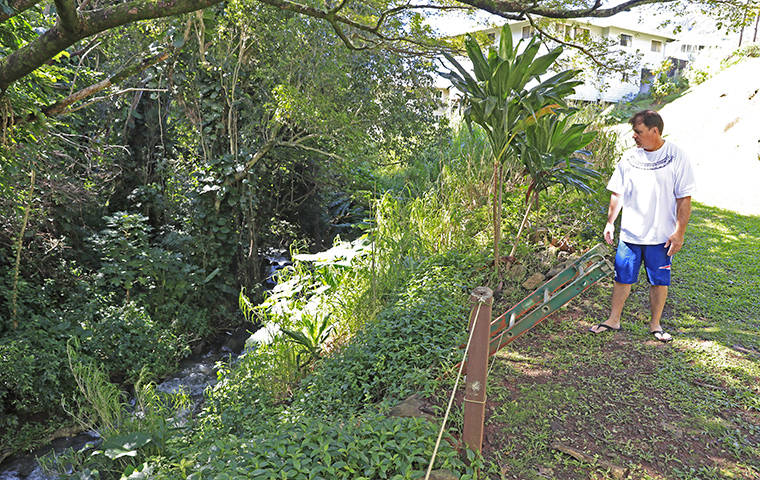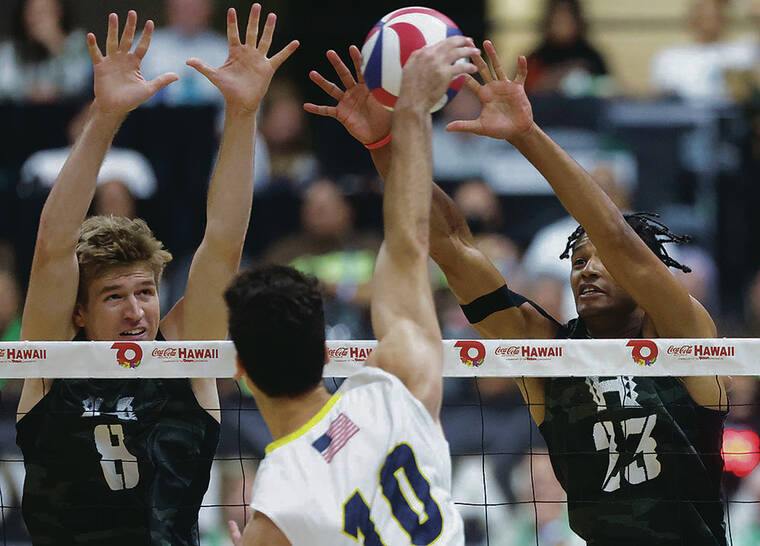Engineers propose changes to Ala Wai flood project

JAMM AQUINO/JAQUINO@STARADVERTISER.COM
Palolo resident Sean Scanlan walks along the grass fringe above Pukele Stream behind his residence on Feb. 3, 2019. The U.S. Army Corps of Engineers is now recommending the removal of two huge basins planned for Pukele and Waiomao streams and improving the system above Manoa Marketplace to increase protection for the University of Hawaii at Manoa and lower Honolulu neighborhoods.
The U.S. Army Corps of Engineers is recommending changes to its $345 million Ala Wai Flood Risk Management Project, including removal of two huge basins planned for Pukele and Waiomao streams and improving the system above Manoa Marketplace to increase protection for the University of Hawaii at Manoa and lower Honolulu neighborhoods.
The recommendation comes nearly a year after staggering pushback from the community, which has included the formation of a Honolulu City Council permitted interaction group, protests and even a lawsuit. While the project has its supporters, there was widespread criticism over the corps’ original plan to build 4-foot concrete walls around the Ala Wai Canal and put six huge flood control structures in the upper reaches of the watershed.
Despite the lack of community consensus or a signed project partnership agreement between the city and the Corps of Engineers, supporters have diligently tried to move the project along. Among their biggest fears is that the next big weather disaster could catch Oahu flat-footed, risking life and racking up billions of dollars in damage, especially to Waikiki, the epicenter of the state’s tourism economy. Another major concern is that the delays could result in the loss of a $220 million emergency appropriation from the federal government, which reduces the community’s share for the project to roughly $125 million.
Almost everyone understands the need to protect Waikiki and several other Oahu neighborhoods from flooding, but there’s been strong debate on the best way to do it. There’s also been criticism of the corps’ public notification process and its handling of public feedback. That’s why seven out of eight neighborhood boards in the affected districts, save for Waikiki, passed resolutions urging government officials to delay the project. It’s also why Protect Our Ala Wai Watersheds, a recently formed community group of mostly Palolo and Manoa residents, filed a lawsuit Sept. 18 to stop the city and state from initiating the project.
Jeff Herzog, project manager for the corps’ Ala Wai flood control project, said he testified to the Honolulu City Council that modifications were coming, but “it took time and coordination to ensure everyone between Washington and Honolulu was aligned on our path forward.”
Based on updated data and community engagement, the corps said it’s now considering altering features in the upper Manoa Valley and removing features in the upper Makiki and Palolo valleys, such as both the Pukele and Waiomao detention basins, where private property was affected. The corps also is recommending replacing some of the walls planned for Ala Wai Canal with earthen berms. Other modifications would extend the Ala Wai Canal barrier along the Manoa Palolo Canal up to the bridge and approximately 1,100 feet into Date Street. The changes aren’t expected to increase the project’s costs, Herzog said.
Don't miss out on what's happening!
Stay in touch with breaking news, as it happens, conveniently in your email inbox. It's FREE!
“There are several things that we need to evaluate to determine what works best to reduce risks. Some may include diversion or bypass channels to catch water that jumps the bank and direct it back into the stream; some alternatives may include multipurpose basins; increased capacity; some alternatives may include gates in basins,” Herzog said.
Herzog said the corps now believes that the highest risk and highest flows are in Manoa Valley and directly affect McCully and Moiliili.
“Based on the updated modeling and terrain data, there are seven different sub-basins or drainage areas that culminate in that Manoa Marketplace area,” he said.
The proposed changes have drawn praise from some, including U.S. Sen. Brian Schatz (D-Hawaii), who was instrumental in obtaining the emergency appropriation to fund the project.
“We are pleased that the Army Corps is showing some flexibility, and that they are listening to community concerns,” Schatz said Friday. “We still have a long way to go. This will require that we rebuild trust and listen to each other, but this is nevertheless good news for all involved. This will help us to honor our commitment to keep people in the Ala Wai watershed safe from flood risk in the era of climate change.”
The state, which is expected to pay the project’s local share, said Friday that it is reviewing the design modifications and will have feedback once the review is complete.
However, Mark Yonamine, deputy director of the city Department of Design and Construction, said the department was briefed on the corps’ proposal and believes “this demonstrates progress in the ongoing back and forth with community members.”
“There is still a lot of work left, but by further engaging residents who live mauka of the Ala Wai Canal, we hope to achieve an effective flood mitigation project that addresses lingering concerns as much as possible,” Yonamine said.
Still, the timing of the proposed changes has evoked skepticism about why the corps issued them before obtaining recommendations from Oceanit, a consultant hired for $100,000 by a permitted interaction group of City Council members Carol Fukunaga, Ann Kobayashi and Tommy Waters.
Fukunaga said Friday that she had not seen the corps’ proposal, but that Oceanit was slated to provide the public with an update at 5:30 p.m. Tuesday at Ala Wai Elementary School.
“There really should be an opportunity for much greater collaboration with the community — after all, the people in these neighborhoods will have to live with whatever is proposed, and we have to be sensitive,” she said.
Kobayashi said Friday that she had not seen the corps’ proposal either and questioned why “they put out these recommendations before getting our Oceanit report.”
“I can’t comment on the changes because they haven’t met with us. I’d like to see drawings, something in writing that reflects their recommendations,” Kobayashi said.
Sidney Lynch, president of Protect Our Ala Wai Watersheds, the organization that is suing the city and state to stop the project, said she is hopeful that the corps appears willing to tweak the project, but has reservations about its intentions.
“It’s good that they are saying that they need to make changes,” Lynch said. “I think that they are trying to give the impression that they are listening to the public finally, but they are still out of step with the process. If they had come out with new recommendations after the Oceanit report, their announcement would have had more validity.”
Herzog said designing a functional system falls to the city and the project team, which includes two city departments and corps representatives from Honolulu, Seattle and New Orleans as well as corps experts in levee and dam safety and risk management. Oceanit is not part of that team, but could offer feedback like other businesses and contractors, he said.
“The recommendations are not final changes to project design. We are just starting to go through and evaluate the system. We will have both small and large audience engagements to communicate with the stakeholders,” he said.
Want to know more about the Ala Wai flood control project?
Meeting: Oceanit, Honolulu City Council permitted interaction group
Date: Tuesday
Time: 5:30-7:30 p.m.
Place: Ala Wai Elementary
Meeting: Protect Our Ala Wai Watersheds presents “A Forum for Alternatives for the Ala Wai Flood Mitigation Project”
Date: Oct. 29
Time: 6:30-8:30 p.m.
Place: Ala Wai Golf Course Clubhouse, second-floor Diamond Head Ballroom
For future public involvement opportunities offered by the U.S. Army Corps of Engineers, visit www.poh.usace.army.mil/Missions/Civil-Works/Civil-Works-Projects/Ala-Wai-Flood-Risk-Management-Project Opens in a new tab.
Questions on the project can be emailed to alawaifloodproject@usace.army.mil.





